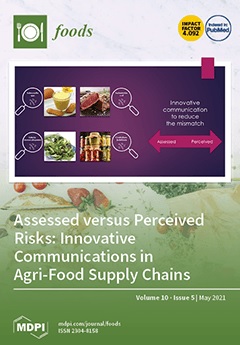View Item
- xmlui.general.dspace_homeCentros Regionales y EEAsCentro Regional Buenos Aires SurEEA BalcarceArtículos científicosxmlui.ArtifactBrowser.ItemViewer.trail
- DSpace Home
- Centros Regionales y EEAs
- Centro Regional Buenos Aires Sur
- EEA Balcarce
- Artículos científicos
- View Item
Relationships among Consumer Liking, Lipid and Volatile Compounds from New Zealand Commercial Lamb Loins
Abstract
Loin sections (m. Longissimus lumborum) were collected at slaughter from forty-eight lamb carcasses to evaluate consumer-liking scores of six types of typical New Zealand commercial lamb and to understand the possible underlying reasons for those ratings. A consumer panel (n = 160) evaluated tenderness, juiciness, flavor liking, and overall liking of the different types of lamb loins. Consumer scores differed among the types of lamb meat for all the
[ver mas...]
Loin sections (m. Longissimus lumborum) were collected at slaughter from forty-eight lamb carcasses to evaluate consumer-liking scores of six types of typical New Zealand commercial lamb and to understand the possible underlying reasons for those ratings. A consumer panel (n = 160) evaluated tenderness, juiciness, flavor liking, and overall liking of the different types of lamb loins. Consumer scores differed among the types of lamb meat for all the evaluated attributes (p < 0.05). Further segmentation based on overall liking scores showed two consumer clusters with distinct ratings. Correlation and external preference map analyses indicated that one consumer cluster (n = 75) liked lamb types that had lower total lipid content, a lower proportion of branched-chain fatty acids, oleic and heptadecanoic acids; and a higher proportion of polyunsaturated fatty acids and volatile compounds (green and fruity descriptors). Consumer liking of the other segment (n = 85) was less influenced by fatty acids and volatiles, except hexanoic, heptanoic and octanoic acids (rancid, fatty, and sweaty descriptors). Thus, the fatty acid profile and the volatile compounds derived from their oxidation upon cooking seem to be a stronger driver of consumer liking of lamb for some consumers than others.
[Cerrar]

Author
Pavan, Enrique;
Yangfan, Ye;
Eyres, Graham T.;
Guerrero, Luis;
Reis, Mariza G.;
Silcock, Patrick;
Johnson, Patricia L.;
Realini, Carolina E.;
Fuente
Foods 10 (5) : 1143 (2021)
Date
2021-05
Editorial
Multidisciplinary Digital Publishing Institute (MDPI)
ISSN
2304-8158
Formato
pdf
Tipo de documento
artículo
Palabras Claves
Derechos de acceso
Abierto
 Excepto donde se diga explicitamente, este item se publica bajo la siguiente descripción: Creative Commons Attribution-NonCommercial-ShareAlike 2.5 Unported (CC BY-NC-SA 2.5)
Excepto donde se diga explicitamente, este item se publica bajo la siguiente descripción: Creative Commons Attribution-NonCommercial-ShareAlike 2.5 Unported (CC BY-NC-SA 2.5)


